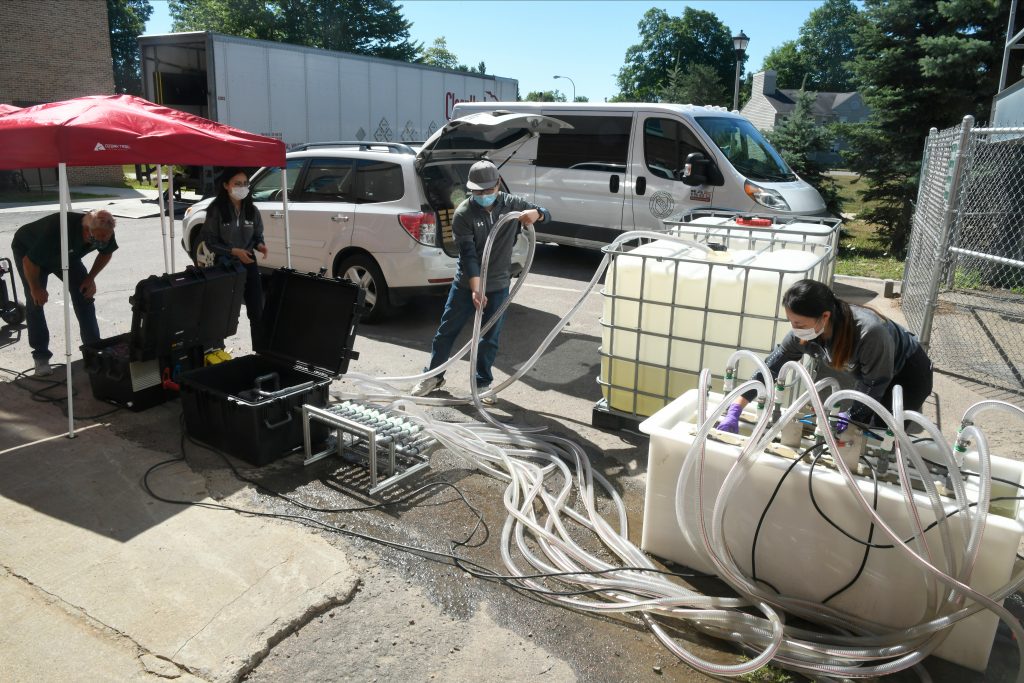The team of Clarkson researchers taking on a challenge from Gov. Andrew M. Cuomo to develop technology that can combat harmful algal blooms (HABs) is gearing up to field test its prototype.

In 2019, Governor Cuomo challenged both Clarkson University and SUNY College of Environmental Science and Forestry (ESF) to use their scientific expertise in water quality to develop new and innovative technologies to reduce the impact of HABs. Clarkson’s electrochemical oxidation process, along with a hydrodynamic cavitation process developed by SUNY ESF, will be tested in Lake Neatahwanta beginning August 24.
In Clarkson’s electrochemical oxidation process, lake water containing blue-green algae is passed through a porous metal oxide filter anode on which an electric potential is applied. Within the anode pores, electrochemically produced oxidants will inactivate algae and destroy cytotoxins. The algae and toxins can also be destroyed directly at
the anode surface via direct oxidation. The treated water is then discharged back to the lake. No chemicals are added and electricity consumption is low compared to other oxidation processes, according to a presentation on the process from Assistant Civil & Environmental Engineering Professor Yang Yang and Professor and Co-Director of the Center of Excellence in Healthy Water Solutions Stefan Grimberg.
“Electrochemical oxidation filtration (EOF) is a cutting-edge decentralized water treatment technology. The compact design, low-foot-print, and high efficiency enables the fast deployment of EOF units to the contaminated sites for emergency response purposes,” Yang said. “Through this project, we proved that the EOF units are scalable and cost-effective. Aside from the control of harmful algae bloom in the lake, we are developing EOF technology for on-site disinfection of hospital wastewater and the elimination of emerging contaminants (e.g., per- and polyfluoroalkyl substances) in landfill leachate and groundwater.”
Yang, who was responsible for inventing the technology, and Grimberg, the project manager, were also assisted by Graduate student Shasha Yang, who has been in charge of the lab testing. Biology Chair Michael Twiss supports the cultivation and detection of cyanobacteria. Machinist Scott Hodge and Supervisor of Technical Support Services Jacob Weller led the modification of the prototype and University Engineer Michael Tremper coordinated test sites on campus.
Phases one and two of the mitigation challenge have been completed, and field testing in Lake Neatahwanta marks the beginning of phase three. Beginning on August 24, researchers begin water quality monitoring until August 31, at which time water treatments begin. After a week of treatments, the group will complete water quality monitoring.
Although most algae are harmless and are an important part of the food web, certain types can grow quickly and form blooms, which can cover all or portions of a lake. Some species of algae can produce toxins resulting in HABs that can be harmful to people and animals. Lake Neatahwanta experiences widespread HABs each year, with high levels of nutrients, algae, and toxins associated with HABs.
Click here for a shareable link: https://www.clarkson.edu/news/clarkson-researchers-set-deploy-technology-combat-harmful-algal-blooms-later-month
